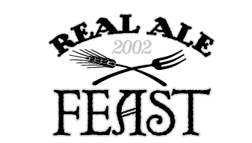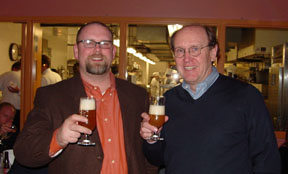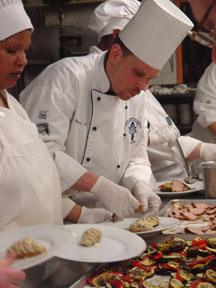A
feast of real ale, real food
Centuries-old brewing tradition revived at Chicago festival
It
was a festival of real ale - and real cuisine. The Real Ale Feast
in Chicago marked the marriage of ale and food in a grand eight-course
repast. But the feast also celebrated the return of craft brewing
to its centuries-old tradition, nurtured in Britain's best pubs, of
naturally carbonated, living, real ale.
"For
the last century, there's been a well-documented decline in the flavor
of mass-produced beer," says Randy Mosher, the talented designer
behind the RAF logo, and one of the members of the Real Ale Festival
team with founder Ray Daniels. "No matter how you measure it,
industrial beer is weaker in malt, weaker in hops, weaker in extract,
and weaker in color and taste."
Real
ale is anything but weak. "Sons of malt," boomed Mark Dorber,
landlord of the White Horse Inn on Parson's Green in London, who came
to Chicago to speak at the dinner, "we champion the cause of
real ale."
Brewed
and fermented at warmer temperatures, real ale is made with a wide
range of malts and hops for a shimmering spectrum of flavors. The
ale is left unfiltered and unpasteurized when transferred from tank
to cask. Teeming with live yeast cells, real ale continues to ferment
in the cask, and thus creates its own delicate carbonation in a secondary
fermentation. This process is also known as "cask conditioning."
"Cask
ale has a mouth-caressing effervescence from this natural carbonation,"
says Dorber. It's a level of excellence difficult for many mainstream
U.S. bars or brewpubs to attain, as cask ale requires care in tapping
and cellaring. In Chicago,  the
Real Ale Festival is hosted by the Goose Island Brewing Co. in Wrigleyville,
whose brewmaster Greg Hall (pictured at right with his father, John
Hall) supports the traditions of cask ale, too. the
Real Ale Festival is hosted by the Goose Island Brewing Co. in Wrigleyville,
whose brewmaster Greg Hall (pictured at right with his father, John
Hall) supports the traditions of cask ale, too.
So, as a team of more than 50 volunteers worked through the night
to rack, stillage, and ready more than 150 examples of real ale from
across the U.S. and U.K., the festival launched its first Feast.
With
the help of chefs Mark Facklam and Tim Bucci of the Cooking and Hospitality
Institute of Chicago, and the guidance of Mark Dorber, the Real Ale
Feast showed a dazzling array of dishes.
From
fresh oysters from British Columbia, paired with the licorice notes
of Walkers Reserve Porter, to a tangy Gorgonzola tart matched with
Stoddard's ESB, the opening hors d'oeuvres set the stage. To "complement
or contrast" were the dual strategies in designing the menu.
"With
real ale you get an additional layer of flavor from the yeast, whether
it's spicy, fruity, woodsy, peppery or even earthy," explained
Mosher. "Depending on your preferences, the contrast or complement
will work."
Grilled
salmon with a malted tomatillo sauce enriched with Tabernash Weiss
ale from Colorado, topped with slivers of fried corn tortillas, had
a spicy taste that literally bounced around the back of my tongue.
Paired with the Damnation Ale, hot with high alcohol, from Russian
River Brewing of California, the combination was breath-taking.
A
slightly salty and chewy pastrami made from house-cured duck breast,
was presented in a salad of wild greens with roasted Anjou pears and
a vinaigrette made with Hansen's Gueuze ale. With each sip of the
New Belgium Trippel, a luscious, spicy Belgian ale, the sharpness
and acidity of the vinaigrette mellowed.
The
elegant Cuvee de Tomme, an award-winning Belgian style ale with four
sources of fermentable sugars (malt, rock candy sugar, cherries and
pureed raisins), was specially brought in by Solana Beach Brewery
of California. It made a formidable match for a venison sausage en
croute with a savory sabayon of New Glarus cherry ale and dried cherries.
Slices
of roast veal, topped with a natural jus of ale and fresh thyme, made
a stunning presentation with Bosco's Flaming Stone Beer from Memphis,
and the Flossmoor Station's Pullman Nut Brown Ale.
In
the final round, Dorber and Mosher pushed the principles of pairing
to the utmost limit. "The carrot cake, paired with an immensely
hoppy 90-Minute IPA from Dogfish Head Brewery of Delaware, was such
an epiphany," raved Mosher. "It was one of those combinations
that turned out to be a magical contrast." However, Dorber laughed
at the odd couple, "Cream cheese frosting and gigantic hops??"
But more diners adored the contrast, as the clean plates and empty
glasses attested.
Of
course, the proof of real ale's appeal is in the drinking. And in
this instance, in the eating, too.
(This review appeared in the food section of the Milwaukee Journal
Sentinel on March 13, 2002)
|